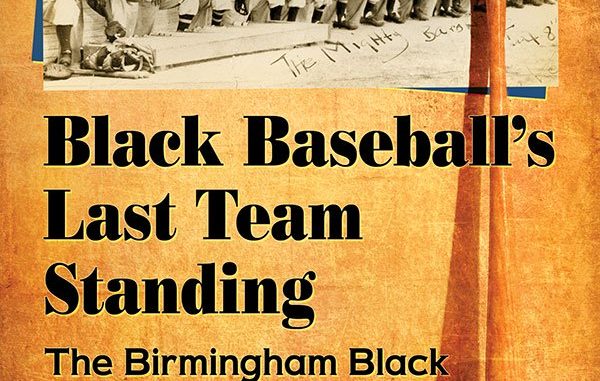
Review Fix chats with “Black Baseball’s Last Team Standing†author William J. Plott, who lets us know why the Barons are so much more than a relic from a lost league.
About the Book:
The Birmingham Black Barons were a nationally known team in baseball’s Negro leagues from 1920 through 1962. Among its storied players were Hall of Famers Satchel Paige, Willie Mays, and Mule Suttles. The Black Barons played in the final Negro Leagues World Series in 1948 and were a major drawing card when barnstorming throughout the United States and parts of Canada. This book chronicles the team’s history and presents the only comprehensive roster of the hundreds of men who wore the Black Barons uniform.
About the Author:
Retired journalist and freelance writer, William J. Plott, a member of the Society for American Baseball Research since 1971, has been a member of SABR’s Negro Leagues Committee since its inception. He was also a member of the Negro Leagues Researchers and Authors Group that compiled Negro league statistics for the Hall of Fame. He lives in Montevallo, Alabama.
Review Fix: What inspired this book?
William J. Plott: I’ve been a lifelong sports fans. I really got into baseball in the 1960s when I lived in Anniston, Alabama and learned that Ty Cobb had once played pro ball there. I began researching the 1904 season and soon learned that just about everything that had been published about that season was erroneous. The name of the team was wrong. The name of the league was wrong. Many other things were also incorrect.
That got me fascinated with historical research, especially sports. I wound up writing a history of the Alabama state high school basketball tournament and a couple of books on high school football.
Then, in 1971 Robert Peterson’s groundbreaking book, Only the Ball Was White, came out. I was suddenly introduced to teams like the Pittsburgh Crawfords, the Homestead Grays, the Nashville Elite Giants, the Montgomery Grey Sox, and the Birmingham Black Barons. I read of players like players like Josh Gibson, Satchel Paige, Cool Papa Bell.
That was just about the same time I joined the Society for American Baseball Research. Several of the founders were friends of mine and fellow researchers. I was in the second tier of SABR members. There are only a few who’ve been members longer than I have.
Review Fix: What was the writing and editing experience like for you?
Plott: I’ve been a journalist and freelancer all of my working life, so writing was not a huge challenge initially. But the longer I researched, the more information I collected and the writing challenge became winnowing all of that material down to a manageable level.
I really enjoy research; it’s like putting pieces of a puzzle together or studying clues in a mystery novel. I worked on this book off and on for about 20 years, accumulating tons of information. When I stated writing, I just put the book together chapter by chapter until it was ready to submit to McFarland. Gary Mitchem, my editor, asked me how long the book was. I had no idea. I had just been happily writing away. When I did a word count it was 220,000 words. “That’s a might meaty manuscript!†said Gary.
Indeed, it was. It took me several weeks to cut it down to about 160,000 words, still a bit long, but it was what I was comfortable with. Happily, McFarland agreed.
Review Fix: What makes it different from other baseball books?
Plott: I’ve read a lot of team histories. I think my book stands out for two reasons. I think it is a good, readable narrative that flows without reading like a dry dissertation. Secondly, I think the appendix is exceptional. I have listed the names of approximately 1,400 players, managers and club officials, along with their dates and positions. I even included the names of some individuals who may have only been on the spring training roster and never actually got in a game. For many families, who always heard that a grandfather or uncle or cousin played for the Black Barons, here is the resource to confirm that family lore.
From a statistical standpoint, I have yearly summaries of the team’s wins and losses, separating league contests from barnstorming exhibitions. I also have such uncommon information as Opening Day attendance and the sites for Spring Training camps.
Review Fix: Did you learn anything you weren’t expecting?
Plott: Oh yes. There were so many games that featured outstanding players. I was always intrigued with baseball before the rise of relief itching as a specialty. There were many games in which pitchers would work 10 or 12 or more innings. Durability was just an expectation in the years before World War II.
And the war years were interesting to research. So many ball players were called into military service, giving cup of coffee opportunities to more marginal players. Sometimes if players were stationed at nearby military installations, they would get passes and spend their weekend leave time playing ball for the local team.
Review Fix: What else makes the two teams featured here [ this team ] so special?
Plott: Birmingham was one of the founding members of the Negro Southern league, which was organized about a month after the Negro National League was founded. They were the first viable leagues for African-American professional baseball teams. Although there were two years during the 1930s when there was no Black Barons team, it basically was in the Negro leagues from the beginning to the end. I draw my title from the last two years of the Negro American League, 1961 and 1962. At the end of each season it was reported that Birmingham and Kansas City were in a playoff for the championship. Each year only the first two games of the playoffs were reported. Each time, Birmingham had won the games reported. So, I arbitrarily declared the Black Barons as the last team standing.
Review Fix: How do you think they’d fare in today’s MLB?
Plott: I think Birmingham’s teams from the 1940s could have held their own for a time, if not in the majors at least at Triple-A level. During those years they were able to maintain a stable lineup from year to year. They had a number of outstanding layers who advanced to Organized Ball, most notably Willie Mays. But Piper Davis, Artie Wilson, Ed Steele, Norman “Bobby†Robinson were outstanding hitters and fielders. During this period, they had a tremendous pitching staff, featuring at various times, Bill Greason, Jimmie Newberry, Nat Pollard, Jay Heard, Bill Powell and Dan Bankhead.
Comparing eras is not something that can be done with any certainty, but yes, I think these teams could have competed with white leaguers.
Review Fix: Who do you think will enjoy this book the most?
Plott: Probably anyone interested in the Negro leagues. However, I think the material is presented in a manner that will make it appealing to anyone who loves baseball. For true fans, the game itself transcends individual players and teams. It is a good companion to my first Negro leagues book, The Negro Southern League, A Baseball History 1919-1951.
Review Fix: What are your goals for this book?
Plott: First, just to present a readable, well-documented history of one of baseball’s storied teams. Second, to do a Henry Louis Gates-type of sharing with the African-American community. I have heard from several families who said this was the first real documentation they had of a relative’s baseball career. Indeed, contact with one of these families resulted in the first known photograph of Buford “Geechie†Meredith, a long-forgotten infielder who played with the Black Barons for a dozen years before his untimely death in a mining accident. Third, to contribute to the general knowledge of the Negro leagues. You will note that I say, “Negro leagues.†I get irritated when I see a reference to The Negro League. There was no such entity. There were many Negro leagues, and they deserve their place in the sun rather than as inclusion in a generic composite.
Review Fix: What’s next for you?
Plott: I’ve always got a project or two under way. Currently, I’m working on another baseball book, one that deals with the white Southern Association, one of the great minor league circuits. I am working on a World War II book based on letters written by my parents while my father was an infantryman in the North Africa and Italy campaigns. I am also working on a biography of a pulp fiction writer named Tom Roan, whose life was about as wild as some of the stories he wrote for Western and detective magazines.
Review Fix: Anything else you’d like to add?
Plott: There are so many worthy projects and so little time. I would love to get into the Negro Texas-Louisiana League, the Negro American Association, and some of the other minor leagues. But since that won’t likely happen, I’ll be happy to help somebody else get started on one of those projects. Any wanna-be Negro leagues researchers out there?


Leave a Reply